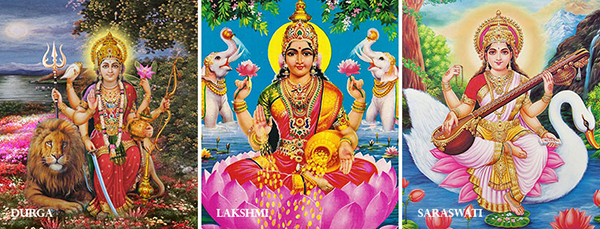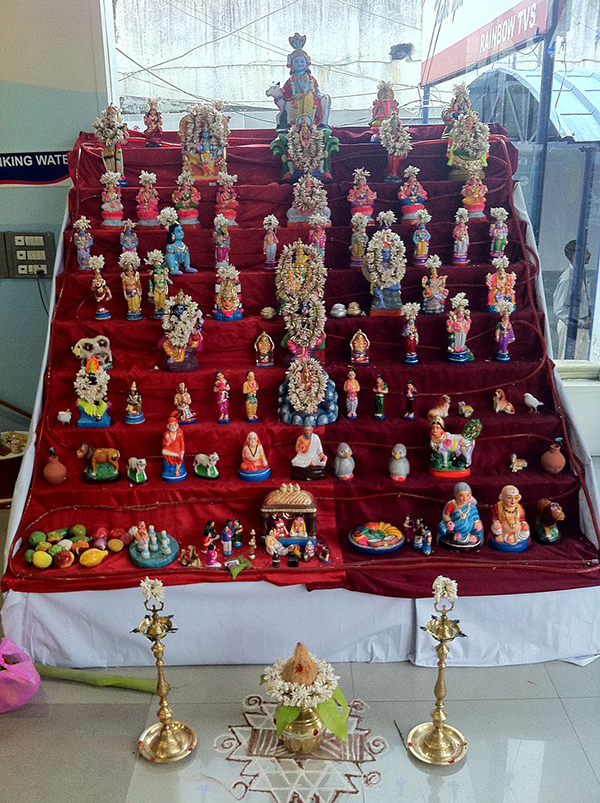
Navaratri Festival
Br. Dayamrita Chaitanya has graciously agreed to address our spiritual questions through the PNW regional newsletter. On the occasion of the
Navaratri festival which falls on October 1 - 10 in 2016, we had asked Swamiji about the significance of this festival devoted to the worship of the Divine Mother. Swamiji says:

In the Indian tradition, out of 365 days in a year, there are more than 465 days of festival! So practically every half day is a festival day. The word festival is a rough translation of the Sanskrit word “Utsav.” “Ut” means removal and “sav” is grief or worldly sorrows. The main reason for celebration is to remove worldly sorrows by remembering our true nature. Festivity does not mean indulgence in worldly pleasures. Sensual indulgence is contrary to the real intention. During Navaratri (meaning nine nights) the devotees observe fasting by drinking only liquids or refraining from food and chant their mantras, especially for Devi - the Divine Mother, an embodiment of Shakti or the power of creation. This is a time to observe fasts, perform spiritual practices, and assess our spiritual progress. Navaratri celebrations have a deep spiritual intention and a very subtle meaning. The nine nights are divided into three three-day periods for each aspect of the Divine Mother - Durga, Lakshmi and Saraswati. Durga Devi rides on a lion which indicates our vasanas or negative tendencies. We conquer the lion of our negative tendencies by fasting and performing spiritual practices. After conquering our vasanas, we come to Goddess Lakshmi, who is the bestower of wealth, both external and internal. A seeker needs only internal wealth as she or he knows that external wealth is ephemeral and of no value. So the seeker asks for internal wealth, which is bestowed by Goddess Saraswati in the form of knowledge on the last three days. The last day is known as Vijaya Dasami or the 10th day of victory. This represents the seeker who, after going through severe austerity during the nine previous days, attains divine knowledge or knowledge of the Self and thus becomes victorious. The Ayudha Puja (meaning worship of the instruments) commences on the evening of the eighth day and ends on the tenth day of Vijaya Dasami. On the eighth day, students place their books on the altar for puja, and elders place their corresponding instruments of trade like computers, calculators, accounting books etc. On the morning of the tenth day everyone performs the Saraswati Puja, also known as Vidya Arambham. This marks the commencement of learning and assimilating Vidya or knowledge. Amma always asks us to be beginners. So, too, humility is required to gather knowledge. Everyone at least acts as a beginner on that day and reads their basic lessons during the puja. On Vijaya Dashami, Amma initiates babies/children into the world of alphabets. The ceremony involves tracing each letter of a mantra (Hari Sree Ganapataye Namah) in a plate of rice or even in sand on the ground. Traditionally, the writing was done on the tongue with gold dipped in honey. It’s a good day for beginners to start lessons on scriptures, music, and instruments. 
There are many rituals and observances followed during Navaratri. Indian houses are decorated with Bommai Kolus. These figurines or dolls in display are of deities and saints and they invoke the divine presence within their homes and internally. During these ten days, women decorate their puja room with these Bommai Kolus and worship them. They also invite their neighbors, relatives and friends and offer sweets and food to them. Since Shakti, symbolized by the female energy of creation, is worshipped during this time, women are given special prominence on these days. In some parts of India, they are also worshipped as embodiments of the divine mother, and there are special rituals and pujas to be performed solely by women during this time. All together these ten days of celebration are to understand who we really are. In Northern India, the tenth day is also celebrated as Dussehra when Lord Rama killed the ten-headed demon Ravana, signifying the death of the ego. Let us pray to Amma to make each day of our life a Vijaya Dashami day. |



Return to Newsletter